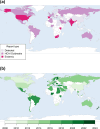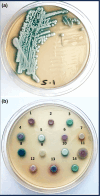The laboratory investigation, management, and infection prevention and control of Candida auris: a narrative review to inform the 2024 national guidance update in England
- PMID: 38771623
- PMCID: PMC11165919
- DOI: 10.1099/jmm.0.001820
The laboratory investigation, management, and infection prevention and control of Candida auris: a narrative review to inform the 2024 national guidance update in England
Abstract
The emergent fungal pathogen Candida auris is increasingly recognised as an important cause of healthcare-associated infections globally. It is highly transmissible, adaptable, and persistent, resulting in an organism with significant outbreak potential that risks devastating consequences. Progress in the ability to identify C. auris in clinical specimens is encouraging, but laboratory diagnostic capacity and surveillance systems are lacking in many countries. Intrinsic resistance to commonly used antifungals, combined with the ability to rapidly acquire resistance to therapy, substantially restricts treatment options and novel agents are desperately needed. Despite this, outbreaks can be interrupted, and mortality avoided or minimised, through the application of rigorous infection prevention and control measures with an increasing evidence base. This review provides an update on epidemiology, the impact of the COVID-19 pandemic, risk factors, identification and typing, resistance profiles, treatment, detection of colonisation, and infection prevention and control measures for C. auris. This review has informed a planned 2024 update to the United Kingdom Health Security Agency (UKHSA) guidance on the laboratory investigation, management, and infection prevention and control of Candida auris. A multidisciplinary response is needed to control C. auris transmission in a healthcare setting and should emphasise outbreak preparedness and response, rapid contact tracing and isolation or cohorting of patients and staff, strict hand hygiene and other infection prevention and control measures, dedicated or single-use equipment, appropriate disinfection, and effective communication concerning patient transfers and discharge.
Conflict of interest statement
The authors declare that there are no conflicts of interest.
Figures


References
Publication types
MeSH terms
LinkOut - more resources
Full Text Sources
Medical

